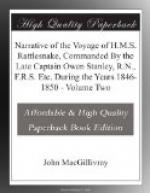On October 21st, the long and anxiously looked-for vessel from Sydney arrived, bringing our supplies, and the letters and news of the last five months. We had for a short time been completely out of bread, peas, and lime juice, and two cases of scurvy had appeared among the crew.
KENNEDY’S EXPEDITION.
It had been arranged that Mr. Kennedy with his expedition should, if possible, be at Cape York in the beginning of October to communicate with us, and receive such supplies and assistance as might be required; but the month passed away without bringing any signs of his being in the neighbourhood. During our progress along the coast a good lookout had been kept for his preconcerted signal—three fires in a line, the central one largest—and bushfires which on two occasions at night assumed somewhat of that appearance had been answered, as agreed on, by rockets sent up at 8 P.M., none of which however were returned. A schooner from Sydney arrived on the 27th with two additions to his party, including a surgeon, also supplies, consisting chiefly of sheep, with instructions from the Colonial Government to await at Port Albany the arrival of the expedition. The livestock were landed by our boats on Albany Island, where a sheep pen was constructed, and a well dug, but the water was too brackish for use. A sufficient supply however had previously been found in a small cave not far off, where the schooner’s boat could easily reach it.
I shall now proceed to give an account of the neighbourhood of Cape York, derived from the present and previous visits, as a place which must eventually become of considerable importance—and first of the aborigines:
NATIVES AT CAPE YORK.
On the day of our arrival at Cape York, a large party of natives crossed over in five canoes under sail from Mount Adolphus Island, and subsequently their numbers increased until at one time no less than 150 men, women, and children, were assembled at Evans Bay. But their stay was short, probably on account of the difficulty of procuring food for so large an assemblage, and the greater part dispersed along the coast to the southward. While collecting materials for a vocabulary,* I found that several dialects were spoken, but I failed then to connect them with particular tribes or even find out which, if any, were the resident ones. Among these were two or three of the Papuan race, from some of the islands of Torres Strait. It appeared to me that a constant friendly intercourse exists between the natives of the southern portion of Torres Strait and those of the mainland about Cape York, which last, from its central position, is much frequented during their occasional, perhaps periodical migrations. This free communication between the races would account for the existence in the vocabulary I then procured at Cape York of a considerable number of words (at least 31 out of 248) identical with those given by Jukes in his vocabularies of Darnley Island and Masseed, especially the latter.




